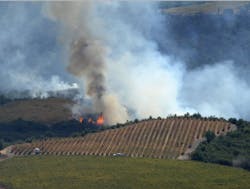Rebuilding with Community Microgrids in Wake of California Fires: Sonoma County
In the wake of the fires that ravaged Sonoma County in October 2017, the Clean Coalition — a non-profit that aims to accelerate the use of clean energy and technologies — is working to create community microgrids in the area.
The organization compares efforts in Sonoma County to work in Puerto Rico, where hurricanes ravaged the island and knocked out power to many residents.
“As the funders of the electrical system, we deserve and should be fighting for abundant, affordable and resilient electricity and community microgrids,” said Greg Thomson, director of the Clean Coalition’s Sonoma County Community Microgrid Initiative, in a recent webinar.
He described some of the options under study by his organization, Pacific Gas and Electric (PG&E) and other groups.
The project focuses on taking advantage of available commercial, industrial and residential roof and parking space to site solar power, and also community microgrids where they can provide power to critical services during outages.
“Our iniative aims to build fire-destroyed areas with high levels of modern carbon-free systems that deliver economic and resilience benefits,” said Thomson.
One of the goals is to provide a model for operating a modern grid that uses the optimal amount of distributed energy resources, storage and renewable energy. Solar and storage can be competitive with grid energy in California, he noted.
For example, one large commercial rooftop might provide 47,600 square feet of photovolatic (PV) space for a system sized 714 kW, says material supplied by the coalition. A large parking lot could supply 37,000 square feet of PV space, or 567 kW of PV.
And 50 average residential/multi-family rooftops could provide 343 square feet of space for PV, with an average system size of 5 kW.
Financial and economic benefits
Under one scenario now under study, 30 MW of solar PV sited on rooftops, in parking lots and on residential housing would provide numerous economic and environmental benefits, including energy benefits of $150 million spent locally, $50 million in avoided transmission costs and $20 million in avoided power interruptions. The project would reap $120 million in new regional impacts, $60 million in added local wages, 1,000 job-years of new employment and $6 million in site leasing income, said Thomson.
Environmental benefits would include 46 million pounds of annual greenhouse gas emission reductions, 10 million gallons of annual water savings and 225 acres of land preserved.
Some of the locations under consideration are areas served by PG&E’s Fulton substation that include large roofs, parking lots for solar placement plus critical services such as hospitals and schools that could be provided with electricity during outages.
Another important goal is to optimize the use of locally produced solar energy across neighborhoods, homes and commercial and industrial areas, Thomson said.
One example would be to generate solar energy at commercial and industrial areas and use that during the week for the industries, but on weekends, when the businesses don’t need as much, share the energy on other feeders connected at substations for use by homeowners, he explained.
The coalition expects to propose some locations in the next two weeks.
The effort also aims to rebuild homes that are efficient, net-zero and include solar panels.
Under a program that’s expected to launch in early May, homeowners could choose all-electric or advanced energy homes, he said. Advanced energy homes would be 20 percent more efficient than code, and would include electric vehicle (EV) charging stations paid for by Sonoma Clean Power. Roofs would have the ability to support solar.
Another option would be an all-electric home that’s 20 percent more efficient than code, with a roof fit for solar and EV charging station.
Homeowners could choose to add solar to the homes or pre-purchase 100 percent renewable energy from Sonoma Clean Power and PG&E, said Thomson.
Community microgrids with grid connections
The project envisions generating 20 to 30 percent of energy needs locally with a microgrid, and to use grid energy as needed.
“Energy would be used and stored locally and when needed used for peak periods like the evening ramp. It’s not a fully islanded thing except when the transmission grid goes down. Then we can have energy generated locally for critical services,” Thomson said.
The community microgrid could generate and store energy locally but if there is an excess, that could be exported to the grid, he said. “That’s a key feature — a distribution grid interfacing with the transmission grid to benefit both.”
He added that “local balancing” would be an important feature. The energy generated locally could be used to reduce peak demand, cut demand charges and defer investments in peaker plants.
“Solar and storage in optimal locations can save across all those aspect of peak usage,” he said.
The project is spearheaded by the Clean Coalition with PG&E, Sonoma Clean Power and organizations such as Rebuild Northbay participating. The webinar is available here.
Interested in community microgrids? Check out Microgrid Knowledge’s community microgrid channel.
About the Author
Lisa Cohn
Contributing Editor
I focus on the West Coast and Midwest. Email me at [email protected]
I’ve been writing about energy for more than 20 years, and my stories have appeared in EnergyBiz, SNL Financial, Mother Earth News, Natural Home Magazine, Horizon Air Magazine, Oregon Business, Open Spaces, the Portland Tribune, The Oregonian, Renewable Energy World, Windpower Monthly and other publications. I’m also a former stringer for the Platts/McGraw-Hill energy publications. I began my career covering energy and environment for The Cape Cod Times, where Elisa Wood also was a reporter. I’ve received numerous writing awards from national, regional and local organizations, including Pacific Northwest Writers Association, Willamette Writers, Associated Oregon Industries, and the Voice of Youth Advocates. I first became interested in energy as a student at Wesleyan University, Middletown, Connecticut, where I helped design and build a solar house.
Twitter: @LisaECohn
Linkedin: LisaEllenCohn
Facebook: Energy Efficiency Markets

